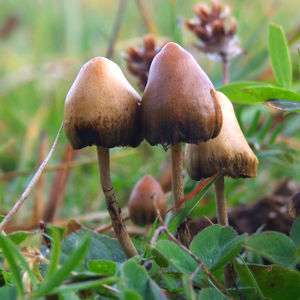Psilocybin
Background
- A compound found in over 200 mushrooms that has mind altering properties similar to LSD.
- Commonly known as "magic mushrooms" or "shrooms". The mushroom are often taken recreationally for the euphoric and hallucinogenic effects. Typically grown in the Pacific Northwest and southern regions of the United States.
- For a typical dose (1mg) symptoms will last 1-3 hours.
- Low toxicity with LD50 of 280mg/kg
- Therapeutic index = 641

Psilocybe semilanceata
Clinical Features
- Sensory/psychiatric
- Euphoria
- Visual hallucinations, synesthesia
- Lethargy, Depression
- Anxiety, agitation
- Confusion, disorientation
- Above may lead to accidental trauma
- Sympathetic effects
- Mydriasis
- Tachycardia
- Hypertension
- Nausea
- Hypotension
Differential Diagnosis
- Hypoglycemia
- TBI
- CO poisoning
- Meningitis/Encephalitis
- Opioid intoxication
- Antihistamines/Anticholinergic toxicity
Drugs of abuse
- 25C-NBOMe
- Alcohol
- Amphetamines
- Bath salts
- Cocaine
- Ecstasy
- Gamma hydroxybutyrate (GHB)
- Heroin
- Inhalant abuse
- Hydrocarbon toxicity
- Difluoroethane (electronics duster)
- Marijuana
- Phencyclidine (PCP)
- Psilocybin ("magic mushrooms")
- Synthetic cannabinoids
Evaluation
- Clinical diagnosis
- Urine drug screen if concerned about co-ingestion
Management
- Supportive care
- Place patient in a calm and quiet environment
- Benzodiazepines for worsening tachycardia/hypertension or agitation
Disposition
- Discharge when vitals normalize and clinically sober
See Also
References
This article is issued from
Wikem.
The text is licensed under Creative
Commons - Attribution - Sharealike.
Additional terms may apply for the media files.